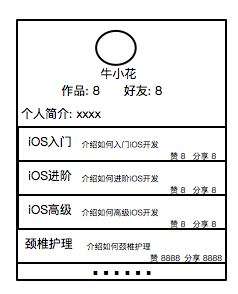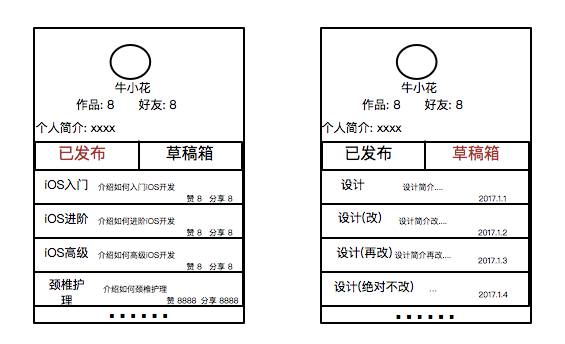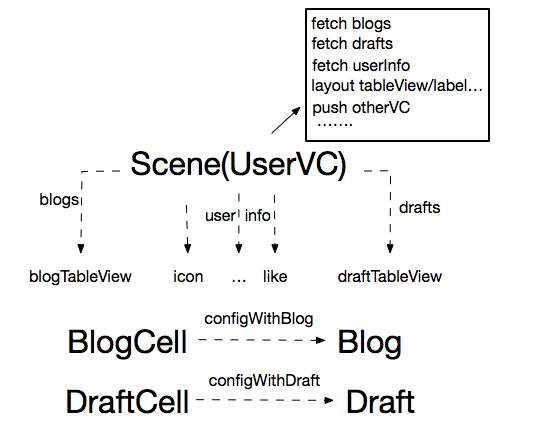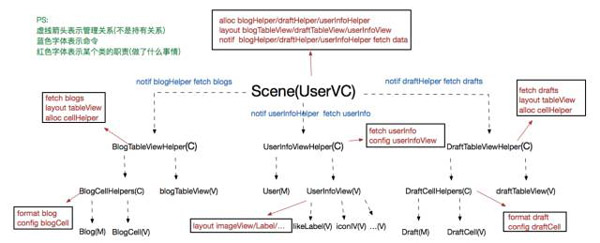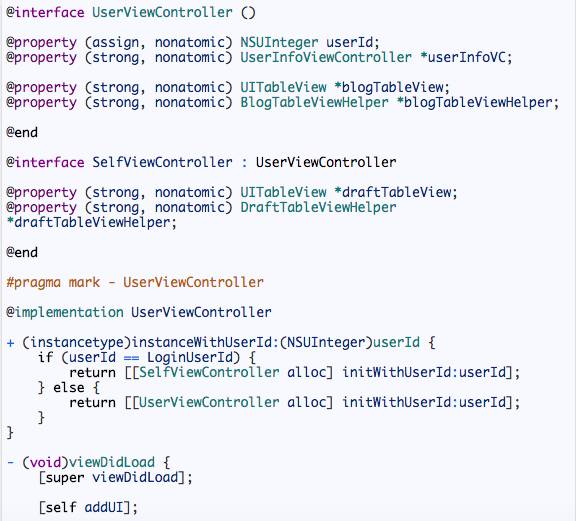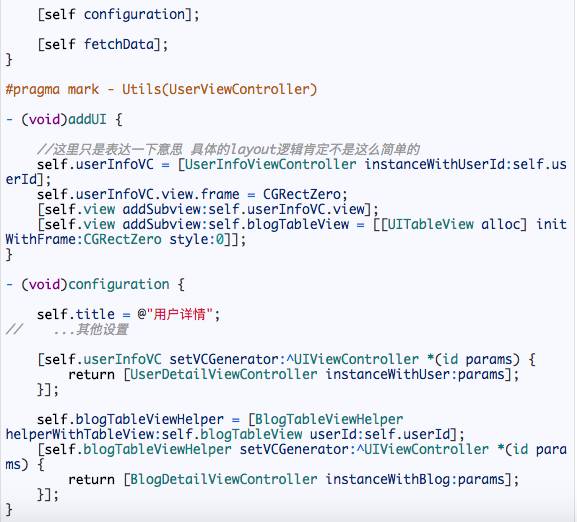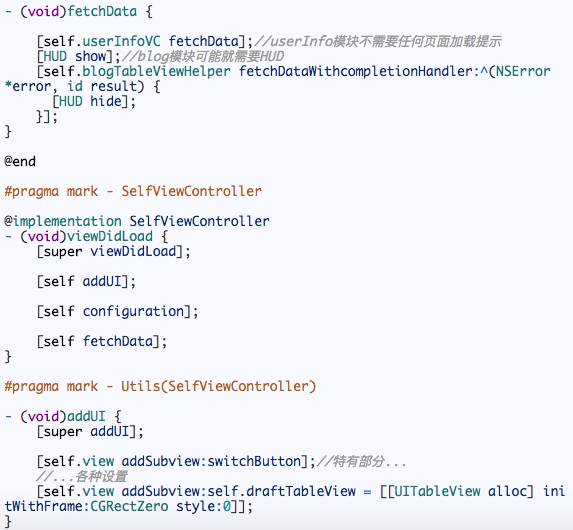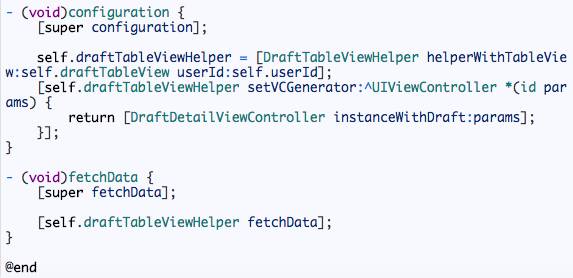前言
本文为回答一位朋友关于MVC/MVP/MVVM架构方面的疑问所写,旨在介绍iOS下MVC/MVP/MVVM三种架构的设计思路以及各自的优缺点。
MVC
- MVC的相关概念
MVC最早存在于桌面程序中的, M是指业务数据, V是指用户界面, C则是控制器. 在具体的业务场景中, C作为M和V之间的连接, 负责获取输入的业务数据, 然后将处理后的数据输出到界面上做相应展示, 另外, 在数据有所更新时, C还需要及时提交相应更新到界面展示. 在上述过程中, 因为M和V之间是完全隔离的, 所以在业务场景切换时, 通常只需要替换相应的C, 复用已有的M和V便可快速搭建新的业务场景. MVC因其复用性, 大大提高了开发效率, 现已被广泛应用在各端开发中.
概念过完了, 下面来看看, 在具体的业务场景中MVC/MVP/MVVM都是如何表现的.
- MVC之消失的C层
上图中的页面(业务场景)或者类似页面相信大家做过不少, 各个程序员的具体实现方式可能各不一样, 这里说说我所看到的部分程序员的写法:
- //UserVC
- - (void)viewDidLoad {
- [super viewDidLoad];
- [[UserApi new] fetchUserInfoWithUserId:132 completionHandler:^(NSError *error, id result) {
- if (error) {
- [self showToastWithText:@"获取用户信息失败了~"];
- } else {
- self.userIconIV.image = ...
- self.userSummaryLabel.text = ...
- ...
- }
- }];
- [[userApi new] fetchUserBlogsWithUserId:132 completionHandler:^(NSError *error, id result) {
- if (error) {
- [self showErrorInView:self.tableView info:...];
- } else {
- [self.blogs addObjectsFromArray:result];
- [self.tableView reloadData];
- }
- }];
- }
- //...略
- - (UITableViewCell *)tableView:(UITableView *)tableView cellForRowAtIndexPath:(NSIndexPath *)indexPath {
- BlogCell *cell = [tableView dequeueReusableCellWithIdentifier:@"BlogCell"];
- cell.blog = self.blogs[indexPath.row];
- return cell;
- }
- - (void)tableView:(UITableView *)tableView didSelectRowAtIndexPath:(NSIndexPath *)indexPath {
- [self.navigationController pushViewController:[BlogDetailViewController instanceWithBlog:self.blogs[indexPath.row]] animated:YES];
- }
- //...略
- //BlogCell
- - (void)setBlog:(Blog)blog {
- _blog = blog;
- self.authorLabel.text = blog.blogAuthor;
- self.likeLebel.text = [NSString stringWithFormat:@"赞 %ld", blog.blogLikeCount];
- ...
- }
程序员很快写完了代码, Command+R一跑, 没有问题, 心满意足的做其他事情去了. 后来有一天, 产品要求这个业务需要改动, 用户在看他人信息时是上图中的页面, 看自己的信息时, 多一个草稿箱的展示, 像这样:
于是小白将代码改成这样:
- //UserVC
- - (void)viewDidLoad {
- [super viewDidLoad];
- if (self.userId != LoginUserId) {
- self.switchButton.hidden = self.draftTableView.hidden = YES;
- self.blogTableView.frame = ...
- }
- [[UserApi new] fetchUserI......略
- [[UserApi new] fetchUserBlogsWithUserId:132 completionHandler:^(NSError *error, id result) {
- //if Error...略
- [self.blogs addObjectsFromArray:result];
- [self.blogTableView reloadData];
- }];
- [[userApi new] fetchUserDraftsWithUserId:132 completionHandler:^(NSError *error, id result) {
- //if Error...略
- [self.drafts addObjectsFromArray:result];
- [self.draftTableView reloadData];
- }];
- }
- - (NSInteger)tableView:(UITableView *)tableView numberOfRowsInSection:(NSInteger)section {
- return tableView == self.blogTableView ? self.blogs.count : self.drafts.count;
- }
- //...略
- - (UITableViewCell *)tableView:(UITableView *)tableView cellForRowAtIndexPath:(NSIndexPath *)indexPath {
- if (tableView == self.blogTableView) {
- BlogCell *cell = [tableView dequeueReusableCellWithIdentifier:@"BlogCell"];
- cell.blog = self.blogs[indexPath.row];
- return cell;
- } else {
- DraftCell *cell = [tableView dequeueReusableCellWithIdentifier:@"DraftCell"];
- cell.draft = self.drafts[indexPath.row];
- return cell;
- }
- }
- - (void)tableView:(UITableView *)tableView didSelectRowAtIndexPath:(NSIndexPath *)indexPath {
- if (tableView == self.blogTableView) ...
- }
- //...略
- //DraftCell
- - (void)setDraft:(draft)draft {
- _draft = draft;
- self.draftEditDate = ...
- }
- //BlogCell
- - (void)setBlog:(Blog)blog {
- ...同上
- }
后来啊, 产品觉得用户看自己的页面再加个回收站什么的会很好, 于是程序员又加上一段代码逻辑 , 再后来…
随着需求的变更, UserVC变得越来越臃肿, 越来越难以维护, 拓展性和测试性也极差. 程序员也发现好像代码写得有些问题, 但是问题具体出在哪里? 难道这不是MVC吗?
我们将上面的过程用一张图来表示:
通过这张图可以发现, 用户信息页面作为业务场景Scene需要展示多种数据M(Blog/Draft/UserInfo), 所以对应的有多个View(blogTableView/draftTableView/image…), 但是, 每个MV之间并没有一个连接层C, 本来应该分散到各个C层处理的逻辑全部被打包丢到了Scene这一个地方处理, 也就是M-C-V变成了MM…-Scene-…VV, C层就这样莫名其妙的消失了.
另外, 作为V的两个cell直接耦合了M(blog/draft), 这意味着这两个V的输入被绑死到了相应的M上, 复用无从谈起.
***, 针对这个业务场景的测试异常麻烦, 因为业务初始化和销毁被绑定到了VC的生命周期上, 而相应的逻辑也关联到了和View的点击事件, 测试只能Command+R, 点点点…
- 正确的MVC使用姿势
也许是UIViewController的类名给新人带来了迷惑, 让人误以为VC就一定是MVC中的C层, 又或许是Button, Label之类的View太过简单完全不需要一个C层来配合, 总之, 我工作以来经历的项目中见过太多这样的”MVC”. 那么, 什么才是正确的MVC使用姿势呢?
仍以上面的业务场景举例, 正确的MVC应该是这个样子的:
UserVC作为业务场景, 需要展示三种数据, 对应的就有三个MVC, 这三个MVC负责各自模块的数据获取, 数据处理和数据展示, 而UserVC需要做的就是配置好这三个MVC, 并在合适的时机通知各自的C层进行数据获取, 各个C层拿到数据后进行相应处理, 处理完成后渲染到各自的View上, UserVC***将已经渲染好的各个View进行布局即可, 具体到代码中如下:
- @interface BlogTableViewHelper : NSObject
- + (instancetype)helperWithTableView:(UITableView *)tableView userId:(NSUInteger)userId;
- - (void)fetchDataWithCompletionHandler:(NetworkTaskCompletionHander)completionHander;
- - (void)setVCGenerator:(ViewControllerGenerator)VCGenerator;
- @end
- @interface BlogTableViewHelper()
- @property (weak, nonatomic) UITableView *tableView;
- @property (copy, nonatomic) ViewControllerGenerator VCGenerator;
- @property (assign, nonatomic) NSUInteger userId;
- @property (strong, nonatomic) NSMutableArray *blogs;
- @property (strong, nonatomic) UserAPIManager *apiManager;
- @end
- #define BlogCellReuseIdentifier @"BlogCell"
- @implementation BlogTableViewHelper
- + (instancetype)helperWithTableView:(UITableView *)tableView userId:(NSUInteger)userId {
- return [[BlogTableViewHelper alloc] initWithTableView:tableView userId:userId];
- }
- - (instancetype)initWithTableView:(UITableView *)tableView userId:(NSUInteger)userId {
- if (self = [super init]) {
- self.userId = userId;
- tableView.delegate = self;
- tableView.dataSource = self;
- self.apiManager = [UserAPIManager new];
- self.tableView = tableView;
- __weak typeof(self) weakSelf = self;
- [tableView registerClass:[BlogCell class] forCellReuseIdentifier:BlogCellReuseIdentifier];
- tableView.header = [MJRefreshAnimationHeader headerWithRefreshingBlock:^{//下拉刷新
- [weakSelf.apiManage refreshUserBlogsWithUserId:userId completionHandler:^(NSError *error, id result) {
- //...略
- }];
- }];
- tableView.footer = [MJRefreshAnimationFooter headerWithRefreshingBlock:^{//上拉加载
- [weakSelf.apiManage loadMoreUserBlogsWithUserId:userId completionHandler:^(NSError *error, id result) {
- //...略
- }];
- }];
- }
- return self;
- }
- #pragma mark - UITableViewDataSource && Delegate
- //...略
- - (NSInteger)tableView:(UITableView *)tableView numberOfRowsInSection:(NSInteger)section {
- return self.blogs.count;
- }
- - (UITableViewCell *)tableView:(UITableView *)tableView cellForRowAtIndexPath:(NSIndexPath *)indexPath {
- BlogCell *cell = [tableView dequeueReusableCellWithIdentifier:BlogCellReuseIdentifier];
- BlogCellHelper *cellHelper = self.blogs[indexPath.row];
- if (!cell.didLikeHandler) {
- __weak typeof(cell) weakCell = cell;
- [cell setDidLikeHandler:^{
- cellHelper.likeCount += 1;
- weakCell.likeCountText = cellHelper.likeCountText;
- }];
- }
- cell.authorText = cellHelper.authorText;
- //...各种设置
- return cell;
- }
- - (void)tableView:(UITableView *)tableView didSelectRowAtIndexPath:(NSIndexPath *)indexPath {
- [self.navigationController pushViewController:self.VCGenerator(self.blogs[indexPath.row]) animated:YES];
- }
- #pragma mark - Utils
- - (void)fetchDataWithCompletionHandler:(NetworkTaskCompletionHander)completionHander {
- [[UserAPIManager new] refreshUserBlogsWithUserId:self.userId completionHandler:^(NSError *error, id result) {
- if (error) {
- [self showErrorInView:self.tableView info:error.domain];
- } else {
- for (Blog *blog in result) {
- [self.blogs addObject:[BlogCellHelper helperWithBlog:blog]];
- }
- [self.tableView reloadData];
- }
- completionHandler ? completionHandler(error, result) : nil;
- }];
- }
- //...略
- @end
- @implementation BlogCell
- //...略
- - (void)onClickLikeButton:(UIButton *)sender {
- [[UserAPIManager new] likeBlogWithBlogId:self.blogId userId:self.userId completionHandler:^(NSError *error, id result) {
- if (error) {
- //do error
- } else {
- //do success
- self.didLikeHandler ? self.didLikeHandler() : nil;
- }
- }];
- }
- @end
- @implementation BlogCellHelper
- - (NSString *)likeCountText {
- return [NSString stringWithFormat:@"赞 %ld", self.blog.likeCount];
- }
- //...略
- - (NSString *)authorText {
- return [NSString stringWithFormat:@"作者姓名: %@", self.blog.authorName];
- }
- @end
Blog模块由BlogTableViewHelper(C), BlogTableView(V), Blogs(C)构成, 这里有点特殊, blogs里面装的不是M, 而是Cell的C层CellHelper, 这是因为Blog的MVC其实又是由多个更小的MVC组成的. M和V没什么好说的, 主要说一下作为C的TableVIewHelper做了什么.
实际开发中, 各个模块的View可能是在Scene对应的Storyboard中新建并布局的, 此时就不用各个模块自己建立View了(比如这里的BlogTableViewHelper), 让Scene传到C层进行管理就行了, 当然, 如果你是纯代码的方式, 那View就需要相应模块自行建立了(比如下文的UserInfoViewController), 这个看自己的意愿, 无伤大雅.
BlogTableViewHelper对外提供获取数据和必要的构造方法接口, 内部根据自身情况进行相应的初始化.
当外部调用fetchData的接口后, Helper就会启动获取数据逻辑, 因为数据获取前后可能会涉及到一些页面展示(HUD之类的), 而具体的展示又是和Scene直接相关的(有的Scene展示的是HUD有的可能展示的又是一种样式或者根本不展示), 所以这部分会以CompletionHandler的形式交由Scene自己处理.
在Helper内部, 数据获取失败会展示相应的错误页面, 成功则建立更小的MVC部分并通知其展示数据(也就是通知CellHelper驱动Cell), 另外, TableView的上拉刷新和下拉加载逻辑也是隶属于Blog模块的, 所以也在Helper中处理.
在页面跳转的逻辑中, 点击跳转的页面是由Scene通过VCGeneratorBlock直接配置的, 所以也是解耦的(你也可以通过didSelectRowHandler之类的方式传递数据到Scene层, 由Scene做跳转, 是一样的).
***, V(Cell)现在只暴露了Set方法供外部进行设置, 所以和M(Blog)之间也是隔离的, 复用没有问题.
这一系列过程都是自管理的, 将来如果Blog模块会在另一个SceneX展示, 那么SceneX只需要新建一个BlogTableViewHelper, 然后调用一下helper.fetchData即可.
DraftTableViewHelper和BlogTableViewHelper逻辑类似, 就不贴了, 简单贴一下UserInfo模块的逻辑:
- @implementation UserInfoViewController
- + (instancetype)instanceUserId:(NSUInteger)userId {
- return [[UserInfoViewController alloc] initWithUserId:userId];
- }
- - (instancetype)initWithUserId:(NSUInteger)userId {
- // ...略
- [self addUI];
- // ...略
- }
- #pragma mark - Action
- - (void)onClickIconButton:(UIButton *)sender {
- [self.navigationController pushViewController:self.VCGenerator(self.user) animated:YES];
- }
- #pragma mark - Utils
- - (void)addUI {
- //各种UI初始化 各种布局
- self.userIconIV = [[UIImageView alloc] initWithFrame:CGRectZero];
- self.friendCountLabel = ...
- ...
- }
- - (void)fetchData {
- [[UserAPIManager new] fetchUserInfoWithUserId:self.userId completionHandler:^(NSError *error, id result) {
- if (error) {
- [self showErrorInView:self.view info:error.domain];
- } else {
- self.user = [User objectWithKeyValues:result];
- self.userIconIV.image = [UIImage imageWithURL:[NSURL URLWithString:self.user.url]];//数据格式化
- self.friendCountLabel.text = [NSString stringWithFormat:@"赞 %ld", self.user.friendCount];//数据格式化
- ...
- }
- }];
- }
- @end
UserInfoViewController除了比两个TableViewHelper多个addUI的子控件布局方法, 其他逻辑大同小异, 也是自己管理的MVC, 也是只需要初始化即可在任何一个Scene中使用.
现在三个自管理模块已经建立完成, UserVC需要的只是根据自己的情况做相应的拼装布局即可, 就和搭积木一样
作为业务场景的的Scene(UserVC)做的事情很简单, 根据自身情况对三个模块进行配置(configuration), 布局(addUI), 然后通知各个模块启动(fetchData)就可以了, 因为每个模块的展示和交互是自管理的, 所以Scene只需要负责和自身业务强相关的部分即可. 另外, 针对自身访问的情况我们建立一个UserVC子类SelfVC, SelfVC做的也是类似的事情.
MVC到这就说的差不多了, 对比上面错误的MVC方式, 我们看看解决了哪些问题:
1.代码复用: 三个小模块的V(cell/userInfoView)对外只暴露Set方法, 对M甚至C都是隔离状态, 复用完全没有问题. 三个大模块的MVC也可以用于快速构建相似的业务场景(大模块的复用比小模块会差一些, 下文我会说明).
2.代码臃肿: 因为Scene大部分的逻辑和布局都转移到了相应的MVC中, 我们仅仅是拼装MVC的便构建了两个不同的业务场景, 每个业务场景都能正常的进行相应的数据展示, 也有相应的逻辑交互, 而完成这些东西, 加空格也就100行代码左右(当然, 这里我忽略了一下Scene的布局代码).
3.易拓展性: 无论产品未来想加回收站还是防御塔, 我需要的只是新建相应的MVC模块, 加到对应的Scene即可.
4.可维护性: 各个模块间职责分离, 哪里出错改哪里, 完全不影响其他模块. 另外, 各个模块的代码其实并不算多, 哪一天即使写代码的人离职了, 接手的人根据错误提示也能快速定位出错模块.
5.易测试性: 很遗憾, 业务的初始化依然绑定在Scene的生命周期中, 而有些逻辑也仍然需要UI的点击事件触发, 我们依然只能Command+R, 点点点…
- MVC的缺点
可以看到, 即使是标准的MVC架构也并非***, 仍然有部分问题难以解决, 那么MVC的缺点何在? 总结如下:
1.过度的注重隔离: 这个其实MV(x)系列都有这缺点, 为了实现V层的完全隔离, V对外只暴露Set方法, 一般情况下没什么问题, 但是当需要设置的属性很多时, 大量重复的Set方法写起来还是很累人的.
2.业务逻辑和业务展示强耦合: 可以看到, 有些业务逻辑(页面跳转/点赞/分享…)是直接散落在V层的, 这意味着我们在测试这些逻辑时, 必须首先生成对应的V, 然后才能进行测试. 显然, 这是不合理的. 因为业务逻辑最终改变的是数据M, 我们的关注点应该在M上, 而不是展示M的V.














